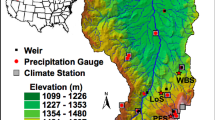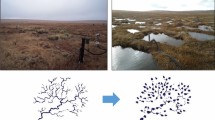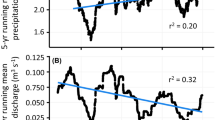Abstract
Sagebrush steppe and lodgepole pine forests are two of the most widespread vegetation types in the western United States and they play crucial roles in the hydrologic cycle of these water-limited regions. We used a process-based ecosystem water model to characterize the potential impact of climate change and disturbance (wildfire and beetle mortality) on water cycling in adjacent sagebrush and lodgepole pine ecosystems. Despite similar climatic and topographic conditions between these ecosystems at the sites examined, lodgepole pine, and sagebrush exhibited consistent differences in water balance, notably more evaporation and drier summer soils in the sagebrush and greater transpiration and less water yield in lodgepole pine. Canopy disturbances (either fire or beetle) have dramatic impacts on water balance and availability: reducing transpiration while increasing evaporation and water yield. Results suggest that climate change may reduce snowpack, increase evaporation and transpiration, and lengthen the duration of dry soil conditions in the summer, but may have uncertain effects on drainage. Changes in the distribution of sagebrush and lodgepole pine ecosystems as a consequence of climate change and/or altered disturbance regimes will likely alter ecosystem water balance.






Similar content being viewed by others
References
Adams HD, Guardiola-Claramonte M, Barron-Gafford GA, Villegas JC, Breshears DD, Zou CB, Troch PA, Huxman TE. 2009. Temperature sensitivity of drought-induced tree mortality portends increased regional die-off under global-change-type drought. Proc Natl Acad Sci USA 106:7063–6.
Adams HD, Luce CH, Breshears DD, Allen CD, Weiler M, Hale VC, Smith AMS, Huxman TE. 2011. Ecohydrological consequences of drought- and infestation-triggered tree die-off: insights and hypotheses. Ecohydrology 5(2):145–59.
Allen CD, Macalady AK, Chenchouni H, Bachelet D, McDowell N, Vennetier M, Kitzberger T, Rigling A, Breshears DD, Hogg EH, Gonzalez P, Fensham R, Zhang Z, Castro J, Demidova N, Lim J-H, Allard G, Running SW, Semerci A, Cobb N. 2010. A global overview of drought and heat-induced tree mortality reveals emerging climate change risks for forests. For Ecol Manag 259:660–84.
Anderegg WRL, Berry JA, Smith DD, Sperry JS, Anderegg LDL, Field CB. 2012. The roles of hydraulic and carbon stress in a widespread climate-induced forest die-off. Proc Natl Acad Sci 109:233–7.
Anderegg WRL, Plavcová L, Anderegg LDL, Hacke UG, Berry JA, Field CB. 2013. Drought’s legacy: multiyear hydraulic deterioration underlies widespread aspen forest die-off and portends increased future risk. Glob Change Biol 19:1188–96.
Barnett TP, Pierce DW, Hidalgo HG, Bonfils C, Santer BD, Das T, Bala G, Wood AW, Nozawa T, Mirin AA, Cayan DR, Dettinger MD. 2008. Human-induced changes in the hydrology of the Western United States. Science 319:1080–3.
Beckage B, Osborne B, Gavin DG, Pucko C, Siccama T, Perkins T. 2008. A rapid upward shift of a forest ecotone during 40 years of warming in the Green Mountains of Vermont. Proc Natl Acad Sci 105:4197–202.
Biederman JA, Brooks PD, Harpold AA, Gochis DJ, Gutmann E, Reed DE, Pendall E, Ewers BE. 2012. Multiscale observations of snow accumulation and peak snowpack following widespread, insect-induced lodgepole pine mortality. Ecohydrology. doi:10.1002/eco.1342.
Bigler C, Gavin DG, Gunning C, Veblen TT. 2007. Drought induces lagged tree mortality in a subalpine forest in the Rocky Mountains. Oikos 116:1983–94.
Bond WJ, Woodward FI, Midgley GF. 2005. The global distribution of ecosystems in a world without fire. New Phytol 165:525–38.
Boon S. 2012. Snow accumulation following forest disturbance. Ecohydrology 5:279–85.
Bouyoucos GJ. 1962. Hydrometer method improved for making particle size analyses of soils. Agron J 54:464–5.
Bradford JB, Lauenroth WK. 2006. Controls over invasion of Bromus tectorum: the importance of climate, soil, disturbance and seed availability. J Veg Sci 17:693–704.
Burton TA. 1997. Effects of basin-scale timber harvest on water yield and peak streamflow. J Am Water Res Assoc 33:1187–96.
Cadenasso ML, Pickett STA, Weathers KC, Bell SS, Benning TL, Carreiro MM, Dawson TE. 2003. An interdisciplinary and synthetic approach to ecological boundaries. Bioscience 53:717–22.
Cayan DR, Das T, Pierce DW, Barnett TP, Tyree M, Gershunov A. 2010. Future dryness in the southwest US and the hydrology of the early 21st century drought. Proc Natl Acad Sci 107(50):21271–6.
CCSP. 2008. A report by the U.S. Climate Change Science Program and the Subcommittee on Global Change Research. In: Karl TR, Meehl GA, Miller CD, Hassol SJ, Waple AM, Murray WL, Eds. Weather and climate extremes in a changing climate. Regions of focus: North America, Hawaii, Caribbean, and U.S. Pacific Islands. Washington, DC: Department of Commerce, NOAA’s National Climatic Data Center.
Cleary MB, Pendall E, Ewers BE. 2008. Testing sagebrush allometric relationships across three fire chronosequences in Wyoming, USA. J Arid Environ 72:285–301.
Cramer W, Bondeau A, Woodward FI, Prentice IC, Betts RA, Brovkin V, Cox PM, Fisher V, Foley JA, Friend AD, Kucharik C, Lomas MR, Ramankutty N, Sitch S, Smith B, White A, Young-Molling C. 2001. Global response of terrestrial ecosystem structure and function to CO2 and climate change: results from six dynamic global vegetation models. Glob Change Biol 7:357–73.
Daly C, Gibson WP, Taylor GH, Johnson GL, Pasteris P. 2002. A knowledge-based approach to the statistical mapping of climate. Clim Res 22:99–113.
Danz NP, Reich PB, Frelich LE, Niemi GJ. 2011. Vegetation controls vary across space and spatial scale in a historic grassland-forest biome boundary. Ecography 34:402–14.
Day TA, DeLucia EH, Smith WK. 1989. Influence of cold soil and snowcover on photosynthesis and leaf conductance in two Rocky Mountain conifers. Oecologia 80:546–52.
Dore S, Montes-Helu M, Hart SC, Hungate BA, Koch GW, Moon JB, Finkral AJ, Kolb TE. 2012. Recovery of ponderosa pine ecosystem carbon and water fluxes from thinning and stand-replacing fire. Glob Change Biol 18:3171–85.
Edburg SL, Hicke JA, Brooks PD, Pendall EG, Ewers BE, Norton U, Gochis D, Gutmann ED, Meddens AJH. 2012. Cascading impacts of bark beetle-caused tree mortality on coupled biogeophysical and biogeochemical processes. Front Ecol Environ 10:416–24.
Ettinger AK, Ford KR, HilleRisLambers J. 2011. Climate determines upper, but not lower, altitudinal range limits of Pacific Northwest conifers. Ecology 92:1323–31.
Fetcher N. 1976. Patterns of leaf resistance to lodgepole pine transpiration in Wyoming. Ecology 57:339–45.
Fritts HC. 1966. Growth-rings of trees: their correlation with climate. Science 154:973–9.
Gerten D, Schaphoff S, Lucht W. 2007. Potential future changes in water limitations of the terrestrial biosphere. Clim Change 80:277–99.
Gordon WS, Famiglietti JS. 2004. Response of the water balance to climate change in the United States over the 20th and 21st centuries: results from the VEMAP Phase 2 model intercomparisons. Glob Biogeochem Cycles 18:1030.
Gosz JR. 1993. Ecotone Hierarchies. Ecol Appl 3:370–6.
Harrison SP, Prentice CI. 2003. Climate and CO2 controls on global vegetation distribution at the last glacial maximum: analysis based on palaeovegetation data, biome modelling and palaeoclimate simulations. Glob Change Biol 9:983–1004.
Huxman TE, Wilcox BP, Breshears DD, Scott RL, Snyder KA, Small EE, Hultine K, Pockman WT, Jackson RB. 2005. Ecohydrological implications of woody plant encroachment. Ecology 86:308–19.
Jackson RB, Jobbágy EG, Nosetto MD. 2009a. Ecohydrology in a human-dominated landscape. Ecohydrology 2:383–9.
Jackson ST, Betancourt JL, Booth RK, Gray ST. 2009b. Ecology and the ratchet of events: climate variability, niche dimensions, and species distributions. Proc Natl Acad Sci USA 106:19685–92.
Kaufmann MR. 1985. Annual transpiration in subalpine forests: large differences among four tree species. For Ecol Manag 13:235–46.
Kaye JP, Hart SC, Cobb RC, Stone JE. 1999. Water and nutrient outflow following the ecological restoration of a ponderosa pine–bunchgrass ecosystem. Restor Ecol 7:252–61.
Kerhoulas LP, Kolb TE, Koch GW. 2013. Tree size, stand density, and the source of water used across seasons by ponderosa pine in northern Arizona. For Ecol Manag 289:425–33.
Knight DH, Fahey TJ, Running SW. 1985. Water and nutrient outflow from contrasting lodgepole pine forests in Wyoming. Ecol Monogr 55:29–48.
Knight DH, Fahey TJ, Running SW, Harrison AT, Wallace LL. 1981. Transpiration from 100-yr-old lodgepole pine forests estimated with whole-tree potometers. Ecology 62:717–26.
Kolb KJ, Sperry JS. 1999a. Transport constraints on water use by the Great Basin shrub, Artemisia tridentata. Plant Cell Environ 22:925–35.
Kolb KJ, Sperry JS. 1999b. Differences in drought adaptation between subspecies of sagebrush (Artemisia tridentata). Ecology 80:2373–84.
Lauenroth WK, Bradford JB. 2006. Ecohydrology and the partitioning AET between transpiration and evaporation in a semiarid steppe. Ecosystems 9:756–67.
Lawler JJ, Shafer SL, White D, Kareiva P, Maurer EP, Blaustein AR, Bartlein PJ. 2009. Projected climate-induced faunal change in the Western Hemisphere. Ecology 90:588–97.
Logan JA, Régnière J, Powell JA. 2003. Assessing the impacts of global warming on forest pest dynamics. Frontiers Ecol Environ 1:130–7.
Lotan JE, Critchfield WB. 1990. Lodgepole Pine. In: Burns RM, Honkala BH, Eds. Silvics of North America, USDA Forest Service Agricultural Handbook, Vol. 1. Washington, DC: USDA. p 654.
MacDonald GM. 2010. Water, climate change, and sustainability in the southwest. Proc Natl Acad Sci 107:21256–62.
Maurer EP, Brekke L, Pruitt T, Duffy PB. 2007. Fine-resolution climate projections enhance regional climate change impact studies. EOS Trans AGU 88:504.
Maurer EP, Wood AW, Adam JC, Lettenmaier DP, Nijssen B. 2002. A long-term hydrologically based dataset of land surface fluxes and states for the conterminous United States. J Clim 15:3237–51.
McArthur ED, Plummer AP. 1978. Biogeography and management of native western shrubs: a case study, section tridentatae of Artemisia. Great Basin Nat Mem 2:229–43.
Mikkelson KM, Maxwell RM, Ferguson I, Stednick JD, McCray JE, Sharp JO. 2013. Mountain pine beetle infestation impacts: modeling water and energy budgets at the hill-slope scale. Ecohydrology 6:64–72.
Minckley TA, Shriver RK, Shuman B. 2011. Resilience and regime change in a southern Rocky Mountain ecosystem during the past 17,000 years. Ecol Monogr 82:49–68.
Mitchell K. 2001. Quantitative analysis by the point-centered quarter method. Geneva: Hobart and William Smith Colleges.
Molotch NP, Brooks PD, Burns SP, Litvak M, Monson RK, McConnell JR, Musselman K. 2009. Ecohydrological controls on snowmelt partitioning in mixed-conifer sub-alpine forests. Ecohydrology 2:129–42.
Monson RK, Sparks JP, Rosenstiel TN, Scott-Denton LE, Huxman TE, Harley PC, Turnipseed AA, Burns SP, Backlund B, Hu J. 2005. Climatic influences on net ecosystem CO2 exchange during the transition from wintertime carbon source to springtime carbon sink in a high-elevation, subalpine forest. Oecologia 146:130–47.
Naithani KJ, Ewers BE, Pendall E. 2012. Sap flux-scaled transpiration and stomatal conductance response to soil and atmospheric drought in a semi-arid sagebrush ecosystem. J Hydrol 464–465:176–85.
Nakicenovic N, Swart R, Eds. 2000. Emissions scenarios: a special report of working group III of the Intergovernmental Panel on Climate Change. Cambridge: Cambridge University Press.
National Climatic Data Center. 2005. Climate maps of the United States. http://cdo.ncdc.noaa.gov/cgi-bin/climaps/climaps.pl. Accessed May 2010.
Neilson RP. 1993. Transient ecotone response to climatic change: some conceptual and modelling approaches. Ecol Appl 3:385–95.
Neitsch S, Arnold J, Kiniry J, Williams J. 2005. Soil and water assessment tool (SWAT) theoretical documentation. version, 2005. Temple, TX: Blackland Research Center, Texas Agricultural Experiment Station.
Newman BD, Wilcox BP, Archer SR, Breshears DD, Dahm CN, Duffy CJ, McDowell NG, Phillips FM, Scanlon BR, Vivoni ER. 2006. Ecohydrology of water-limited environments: a scientific vision. Water Resour Res 42:06302.
Parton WJ. 1978. Abiotic section of ELM. In: Innis GS, Ed. Grassland simulation model. New York: Springer-Verlag. p 31–53.
Pataki DE, Oren R, Smith WK. 2000. Sap flux of co-occurring species in a western subalpine forest during seasonal soil drought. Ecology 81:2557–66.
Pearson JA, Fahey TJ, Knight DH. 1984. Biomass and leaf-area in contrasting lodgepole pine forests. Can J For Res 14:259–65.
Porporato A, Daly E, Rodriguez , ÄêIturbe I. 2004. Soil water balance and ecosystem response to climate change. Am Nat 164:625–32.
Raffa KF, Aukema BH, Bentz BJ, Carroll AL, Hicke JA, Turner MG, Romme WH. 2008. Cross-scale drivers of natural disturbances prone to anthropogenic amplification: the dynamics of bark beetle eruptions. Bioscience 58:501–17.
Ryel R, Caldwell M, Yoder C, Or D, Leffler A. 2002. Hydraulic redistribution in a stand of Artemisia tridentata: evaluation of benefits to transpiration assessed with a simulation model. Oecologia 130:173–84.
Sala OE, Lauenroth WK, Parton WJ. 1992. Long-term soil-water dynamics in the shortgrass steppe. Ecology 73:1175–81.
Samman S, Logan J. 2000. Assessment and response to bark beetle outbreaks in the Rocky Mountain area: Report to Congress from Forest Health Protection, Washington Office, Forest Service, U.S. Department of Agriculture. General Technical Report RMRS-GTR-62. Ogden, UT: U.S. Department of Agriculture, Forest Service, Rocky Mountain Research Station, 46 p.
Schlaepfer DR, Lauenroth WK, Bradford JB. 2012a. Consequences of declining snow accumulation for water balance of mid-latitude dry regions. Glob Change Biol 18:1988–97.
Schlaepfer DR, Lauenroth WK, Bradford JB. 2012b. Ecohydrological niche of sagebrush ecosystems. Ecohydrology 5:453–66.
Schlaepfer DR, Lauenroth WK, Bradford JB. 2012c. Effects of ecohydrological variables on current and future ranges, local suitability patterns, and model accuracy in big sagebrush. Ecography 35:374–84.
Seager R, Vecchi GA. 2010. Greenhouse warming and the 21st century hydroclimate of southwestern North America. Proc Natl Acad Sci 107:21277–82.
Seyfried MS, Schwinning S, Walvoord MA, Pockman WT, Newman BD, Jackson RB, Phillips EM. 2005. Ecohydrological control of deep drainage in arid and semiarid regions. Ecology 86:277–87.
Spittlehouse DL. 2002. Sap flow and transpiration of old lodgepole pine trees. . Proceedings 25th Conference on Agricultural and Forest Meteorology, 20–24 May 2002, Norfolk, Virginia. American Meteorological Society, Boston, MA.
Stahle DW, Cleaveland MK, Grissino-Mayer HD, Griffin RD, Fye FK, Therrell MD, Burnette DJ, Meko DM, Villanueva Diaz J. 2009. Cool- and warm-season precipitation reconstructions over Western New Mexico. J Clim 22:3729–50.
Sterling SM, Ducharne A, Polcher J. 2012. The impact of global land-cover change on the terrestrial water cycle. Nature Clim Change 3(4):385–90.
Strayer DL, Power ME, Fagan WF, Pickett STA, Belnap J. 2003. A classification of ecological boundaries. Bioscience 53:723–9.
Troendle CA, King RM. 1985. The effect of timber harvest on the Fool Creek Watershed, 30 years later. Water Resour Res 21:1915–22.
Turnbull L, Wilcox BP, Belnap J, Ravi S, D’Odorico P, Childers D, Gwenzi W, Okin G, Wainwright J, Caylor KK, Sankey T. 2011. Understanding the role of ecohydrological feedbacks in ecosystem state change in drylands. Ecohydrology 5:174–83.
van der Heijden G, Legout A, Pollier B, Bréchet C, Ranger J, Dambrine E. 2013. Tracing and modeling preferential flow in a forest soil—potential impact on nutrient leaching. Geoderma 195–196:12–22.
Viville D, Biron P, Granier A, Dambrine E, Probst A. 1993. Interception in a mountainous declining spruce stand in the Strengbach catchment. J Hydrol 144:273–82.
Wang G. 2011. Assessing the potential hydrological impacts of hydraulic redistribution in Amazonia using a numerical modeling approach. Water Resour Res 47:W02528.
Warren JM, Meinzer FC, Brooks JR, Domec JC, Coulombe R. 2007. Hydraulic redistribution of soil water in two old-growth coniferous forests: quantifying patterns and controls. New Phytol 173:753–65.
West NE, Young JA. 2000. Intermountain valleys and lower mountain slopes. In: Barbour MG, Billings WD, Eds. North American terrestrial vegetation. Cambridge: Cambridge University Press. p 255–84.
Westerling AL, Hidalgo HG, Cayan DR, Swetnam TW. 2006. Warming and earlier spring increase western U.S. forest wildfire activity. Science 313:940–3.
Wetherald RT, Manabe S. 2002. Simulation of hydrologic changes associated with global warming. J Geophys Res 107:4379.
Wilcox BP. 2010. Transformative ecosystem change and ecohydrology: ushering in a new era for watershed management. Ecohydrology 3:126–30.
Wilcox BP, Seyfried MS, Breshears DD, McDonnell JJ. 2012. Ecohydrologic connections and complexities in drylands: new perspectives for understanding transformative landscape change. Ecohydrology 5:143–4.
Williams AP, Allen CD, Millar CI, Swetnam TW, Michaelsen J, Still CJ, Leavitt SW. 2010. Forest responses to increasing aridity and warmth in the southwestern United States. Proc Natl Acad Sci 107(50):21289–94.
Williams PA, Allen CD, Macalady AK, Griffin D, Woodhouse CA, Meko DM, Swetnam TW, Rauscher SA, Seager R, Grissino-Mayer HD, Dean JS, Cook ER, Gangodagamage C, Cai M, McDowell NG. 2012. Temperature as a potent driver of regional forest drought stress and tree mortality. Nat Clim Change 3(3):292–7.
Yarrow MM, Marín VH. 2007. Toward conceptual cohesiveness: a historical analysis of the theory and utility of ecological boundaries and transition zones. Ecosystems 10:462–76.
Yarrow MM, Salthe SN. 2008. Ecological boundaries in the context of hierarchy theory. Biosystems 92:233–44.
Yoder R, Odhiambo L, Wright W. 2005. Effects of vapor–pressure deficit and net-irradiance calculation methods on accuracy of standardized penman–monteith equation in a humid climate. J Irrigation Drainage Eng 131:228–37.
Zou CB, Breshears DD, Newman BD, Wilcox BP, Gard MO, Rich PM. 2008. Soil water dynamics under low- versus high-ponderosa pine tree density: ecohydrological functioning and restoration implications. Ecohydrology 1:309–15.
Acknowledgments
Eddy covariance and soil moisture data from Chimney Park presented in Appendix 4 were generously provided by Elise Pendall and Brent Ewers, processed by David Reed (all University of Wyoming), with funding support from McIntire-Stennis, Wyoming Water Development Commission, US Geological Survey and National Science Foundation through Emerging Topics in Biogeochemical Cycles. Any use of trade, product, or firm names is for descriptive purposes only and does not imply endorsement by the US Government.
Author information
Authors and Affiliations
Corresponding author
Additional information
Author Contributions
JB, DS, and WL conceived of and designed the study; JB and DS performed research and analyzed the data; JB, DS, and WL wrote the paper.
Electronic supplementary material
Below is the link to the electronic supplementary material.
Rights and permissions
About this article
Cite this article
Bradford, J.B., Schlaepfer, D.R. & Lauenroth, W.K. Ecohydrology of Adjacent Sagebrush and Lodgepole Pine Ecosystems: The Consequences of Climate Change and Disturbance. Ecosystems 17, 590–605 (2014). https://doi.org/10.1007/s10021-013-9745-1
Received:
Accepted:
Published:
Issue Date:
DOI: https://doi.org/10.1007/s10021-013-9745-1




